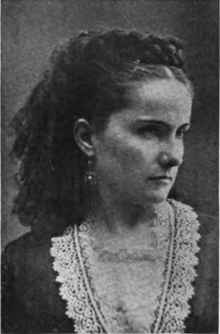Eunice Eloisae Gibbs Allyn
| Eunice Eloisae Gibbs Allyn | |
|---|---|
 | |
| Born |
Eunice Eloisae Gibbs 1847 Brecksville, Ohio, US |
| Died |
June 30, 1916 Dubuque, Iowa |
| Occupation | correspondent, author, songwriter |
| Language | English |
| Nationality | US |
| Genre | poetry, prose |
| Notable works | "The Cats' Convention" |
| Spouse | Clarence G. Allyn |
Eunice Eloisae Gibbs Allyn (1847 - June 30, 1916) was an American correspondent, author of poetry and prose, and songwriter. She intended to become a teacher, but her mother dissuaded her so she remained at home, entering into society, and writing in a quiet way for the local papers while using various pen names in order to avoid displeasing one of her brothers, who did not wish to have a "bluestocking" in the family.
Allyn served as the Washington correspondent for the Chicago Inter Ocean, as well as a writer for the St. Louis Globe-Democrat and the New York World, and also contributed prose and verse to various US publications. She won distinction as an artist and lecturer. For eight years, she served as president of the Dubuque branch of the Woman’s Christian Temperance Union (WCTU).[1]
Early years and education
Eunice Eloisae Gibbs was born in 1847,[2] in Brecksville, Ohio, a suburb of Cleveland, Ohio. Her father, Dr. Sidney Smith Gibbs, hailed from Schoharie County, New York, and her mother, Eunice Lucinda Newberry, was from St. Lawrence County, New York. Dr. Gibbs was practicing medicine in Brecksvilie when he married Miss Newberry, who was a successful teacher. He was a relative of the Anglican cleric, wit, and writer, Sydney Smith.[3]
The family consisted of four children, of whom Eunice was the third. After various changes of climate in search of health, Dr. Gibbs died young. The mother and children then moved from Jackson, Michigan, to Cleveland, where Eunice was graduated with honors from the high school.[3]
Career
Allyn intended to become a teacher, but her mother dissuaded her and she remained at home, entering into society and writing quietly for the local papers. Her articles were signed using various pen names in order to avoid displeasing one of her brothers, who did not wish to have a "bluestocking" in the family. Her first published poems appeared in the Cleveland Plain Dealer, when she was only thirteen years old. Besides composing poems for recitation in school, she often wrote songs, both words and music, when she could not find songs suited to various occasions.[3]
In 1873, she married Clarence G. Allyn (born 1845), of Nyack, New York. After spending several years at Nyack, New London, Connecticut, and Auburn, New York, they moved to Dubuque, Iowa.[3] Before her marriage she gained valuable experience as Washington correspondent of the Chicago Inter Ocean a position which she filled for a year, during which time she also wrote numerous articles for the St. Louis Globe-Democrat, the New York World, and before and since marriage, for various New York City, Boston, Indianapolis, Philadelphia, and Chicago journals. She was a pointed, incisive writer, and all her work, prose or poetry, had an aim, a central thought.[3]
Personal life
Allyn was a prominent member of the Dubuque Ladies' Literary Union, and for eight years, she served as president of the Dubuque WCTU. She also won distinction as an artist. She was a member of the Episcopal Church, and an ardent admirer of Oriental philosophy. In Dubuque, she inaugurated many reforms and educational movements, doing the work, not for notoriety, but prompted by her inborn desire to do something towards lifting up humanity.[3]
Allyn died at her home in Dubuque on June 30, 1916,[4] following a lengthy illness. An effort began two years before her death to collect her literary works for preservation in the state historical archives.[5]
The Cats' Convention review
.png)
Allyn's The Cats' Convention was published by Cochrane Publishing Co., New York (1909). It was reviewed by Watson's Jeffersonian Magazine the following year.[6] The work is illustrated with drawings of many cats of various styles, some beautiful and others ugly, all created by Allyn.[7]
What Black Beauty has spoken in behalf of the horse, what Bob, Son of Battle, has revealed of the thoroughbred collie, what The Bar Sinister has shown of the mongrel dog, this book will mean to the cat, aristocratic or plebian. As to its literary merits, no reviewer could do justice. To say that it is a classic is the nearest approach one can make. It is not a book to be scanned, neither does the term reading adequately apply, for one is not conscious at all of the printed page but. with smiles and tears, sees simply a vision of the real life— yea, the heart life—of the daintiest creatures under the sun. Artists have said that to paint the cat is the most difficult of all their subjects. To write of them requires that rare combination of love, imagination, humor and tenderness which heretofore has not been found dedicated to this theme and which at last appears in the pen of Mrs. Allyn. In form, binding and illustration, "The Cats' Convention" is presented as beautifully as the story deserves. Mechanical art has aided genius in bringing forth a book which is a privilege to read, a treasure to own.
Selected works
References
- ↑ Herringshaw 1904, p. 38.
- ↑ "Eunice G Allyn". Census Records. Retrieved 11 April 2017.
- 1 2 3 4 5 6 Willard & Livermore 1897, p. 21-22.
- ↑ The Cedar Rapids Evening Gazette 1916, p. 6.
- ↑ The Des Moines Register 1914, p. 12.
- ↑ Watson 1910, p. 702.
- ↑ Carleton 1910, p. 211.
- ↑ Library of Congress, Copyright Office 1903, p. 193.
- ↑ Library of Congress, Copyright Office 1903, p. 555.
- ↑ Allyn 1909.
Bibliography










External links

- Works by or about Eunice Eloisae Gibbs Allyn at Internet Archive